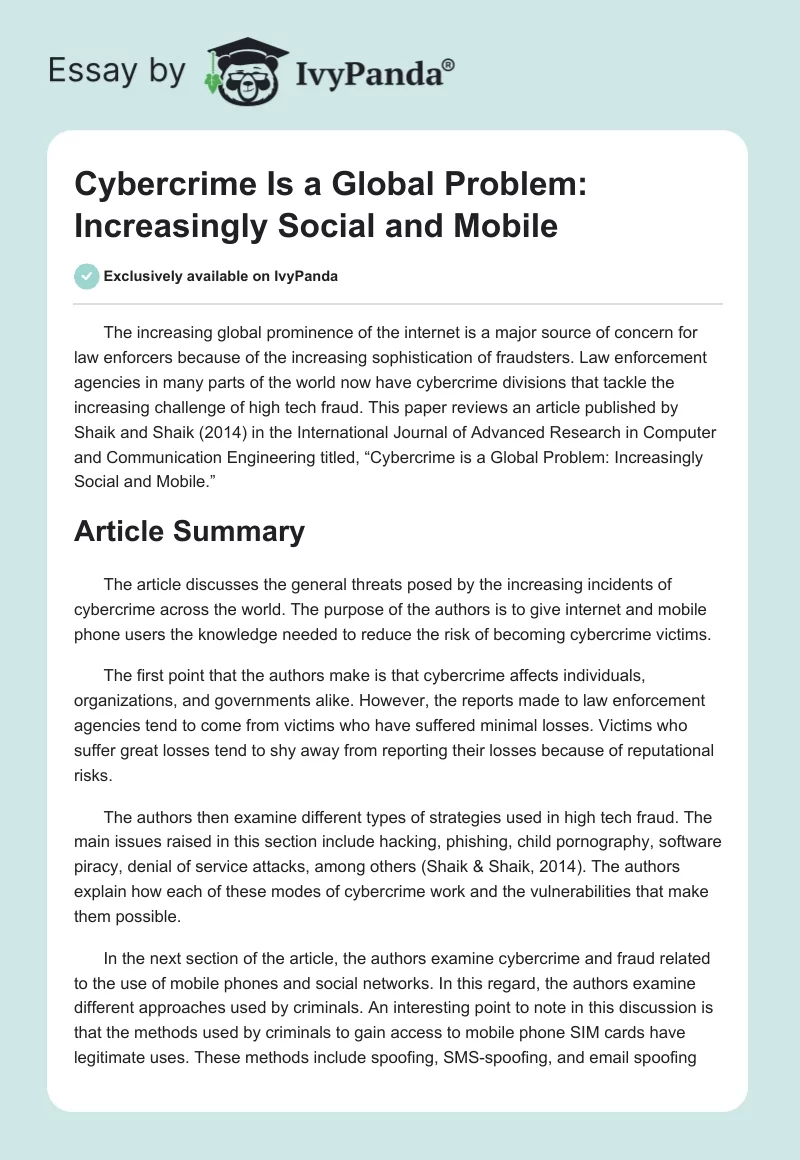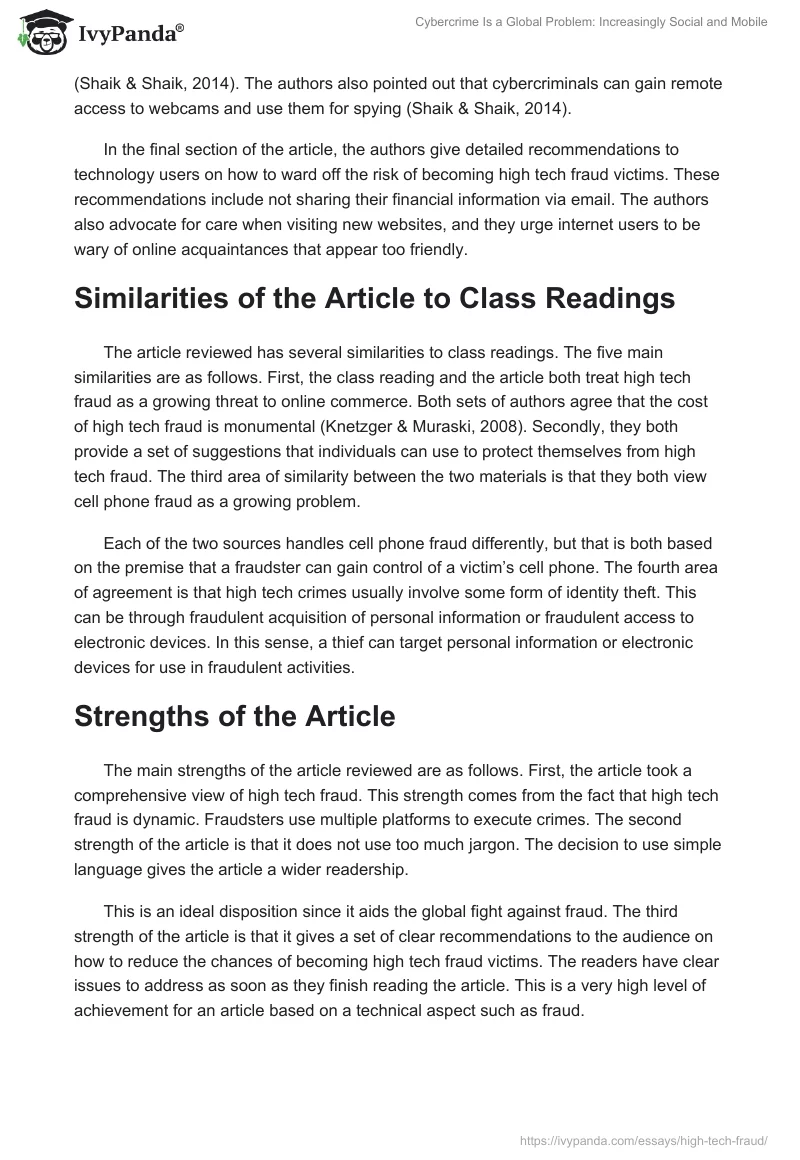The increasing global prominence of the internet is a major source of concern for law enforcers because of the increasing sophistication of fraudsters. Law enforcement agencies in many parts of the world now have cybercrime divisions that tackle the increasing challenge of high tech fraud. This paper reviews an article published by Shaik and Shaik (2014) in the International Journal of Advanced Research in Computer and Communication Engineering titled, “Cybercrime is a Global Problem: Increasingly Social and Mobile.”
Article Summary
The article discusses the general threats posed by the increasing incidents of cybercrime across the world. The purpose of the authors is to give internet and mobile phone users the knowledge needed to reduce the risk of becoming cybercrime victims.
The first point that the authors make is that cybercrime affects individuals, organizations, and governments alike. However, the reports made to law enforcement agencies tend to come from victims who have suffered minimal losses. Victims who suffer great losses tend to shy away from reporting their losses because of reputational risks.
The authors then examine different types of strategies used in high tech fraud. The main issues raised in this section include hacking, phishing, child pornography, software piracy, denial of service attacks, among others (Shaik & Shaik, 2014). The authors explain how each of these modes of cybercrime work and the vulnerabilities that make them possible.
In the next section of the article, the authors examine cybercrime and fraud related to the use of mobile phones and social networks. In this regard, the authors examine different approaches used by criminals. An interesting point to note in this discussion is that the methods used by criminals to gain access to mobile phone SIM cards have legitimate uses. These methods include spoofing, SMS-spoofing, and email spoofing (Shaik & Shaik, 2014). The authors also pointed out that cybercriminals can gain remote access to webcams and use them for spying (Shaik & Shaik, 2014).
In the final section of the article, the authors give detailed recommendations to technology users on how to ward off the risk of becoming high tech fraud victims. These recommendations include not sharing their financial information via email. The authors also advocate for care when visiting new websites, and they urge internet users to be wary of online acquaintances that appear too friendly.
Similarities of the Article to Class Readings
The article reviewed has several similarities to class readings. The five main similarities are as follows. First, the class reading and the article both treat high tech fraud as a growing threat to online commerce. Both sets of authors agree that the cost of high tech fraud is monumental (Knetzger & Muraski, 2008). Secondly, they both provide a set of suggestions that individuals can use to protect themselves from high tech fraud. The third area of similarity between the two materials is that they both view cell phone fraud as a growing problem.
Each of the two sources handles cell phone fraud differently, but that is both based on the premise that a fraudster can gain control of a victim’s cell phone. The fourth area of agreement is that high tech crimes usually involve some form of identity theft. This can be through fraudulent acquisition of personal information or fraudulent access to electronic devices. In this sense, a thief can target personal information or electronic devices for use in fraudulent activities.
Strengths of the Article
The main strengths of the article reviewed are as follows. First, the article took a comprehensive view of high tech fraud. This strength comes from the fact that high tech fraud is dynamic. Fraudsters use multiple platforms to execute crimes. The second strength of the article is that it does not use too much jargon. The decision to use simple language gives the article a wider readership.
This is an ideal disposition since it aids the global fight against fraud. The third strength of the article is that it gives a set of clear recommendations to the audience on how to reduce the chances of becoming high tech fraud victims. The readers have clear issues to address as soon as they finish reading the article. This is a very high level of achievement for an article based on a technical aspect such as fraud.
Weaknesses of the Article
The two main weaknesses of the article are as follows. First, the article has a poor structure. The authors tried too hard to categorize issues into a few clear areas. The result is that some sections of the article do not fit well in their current categories. For instance, the section talking about “buffer overflows” also discusses zombie computers and skimming (Shaik & Shaik, 2014, p. 4998).
The relationship between these concepts is not obvious. The second weakness of the article is that its recommendations are too prescriptive. They do not allow the reader to use the information provided in any other way. In this sense, the applications possible from this paper are limited to the ones identified by the authors.
References
Knetzger, M., & Muraski, J. (2008). Investigating High Tech Crime. Carlifornia: Pearson.
Shaik, A., & Shaik, S. B. (2014). Cybercrime is a Global Problem: Increasingly Social and Mobile. International Journal of Advanced Research in Computer and Communication Engineering, 3(1), 4993-5001.


